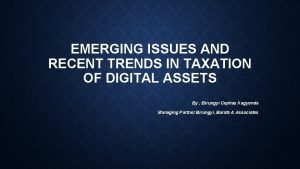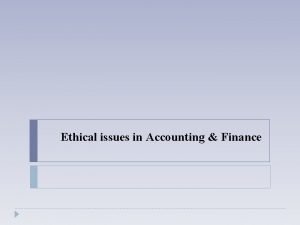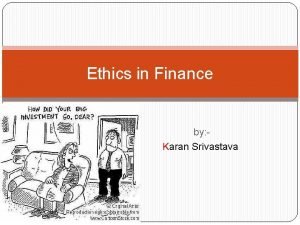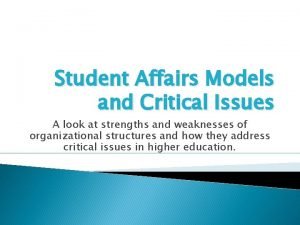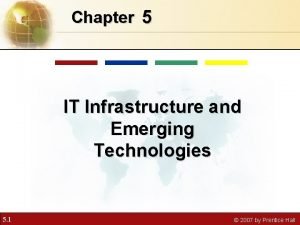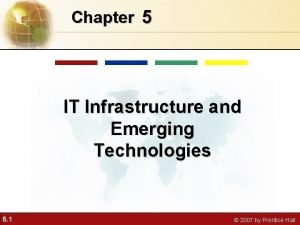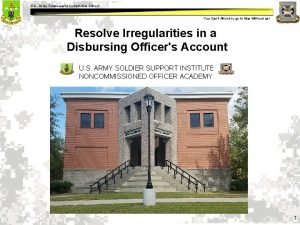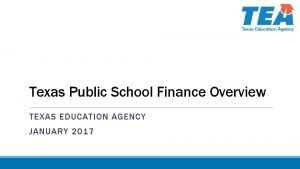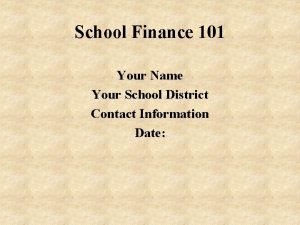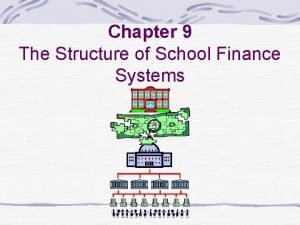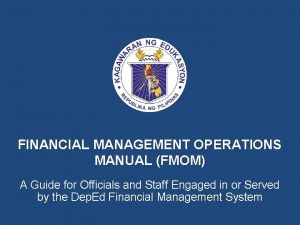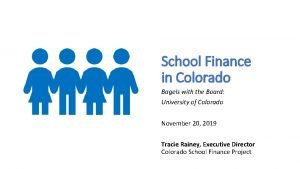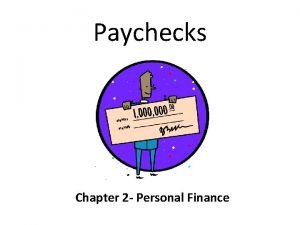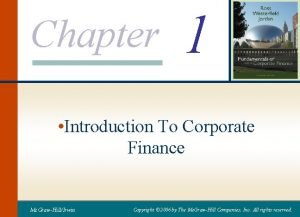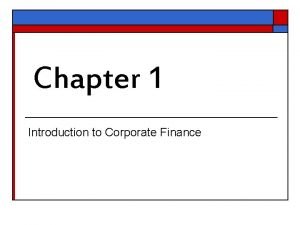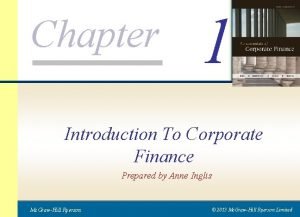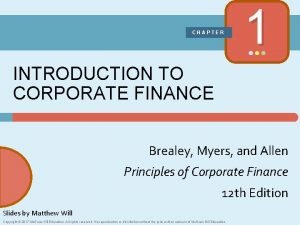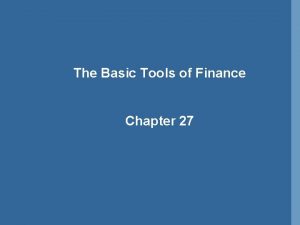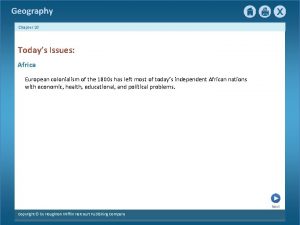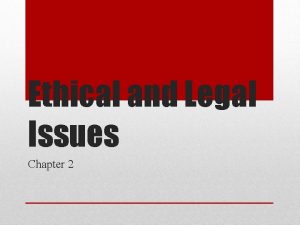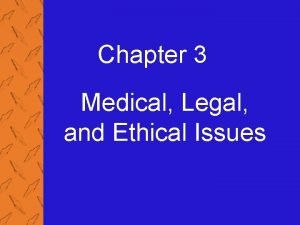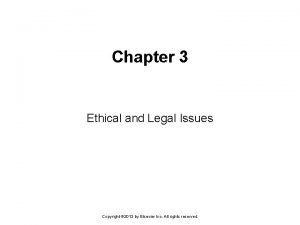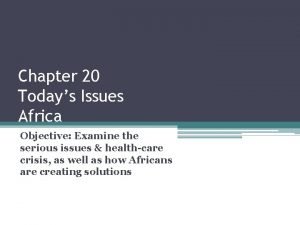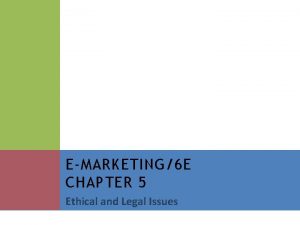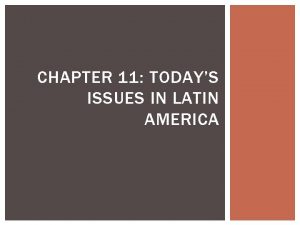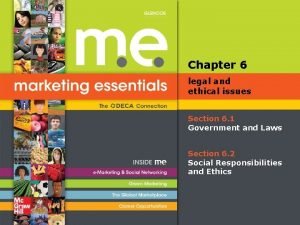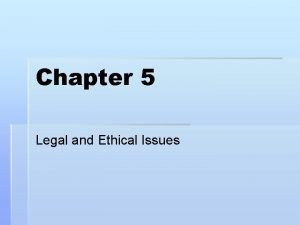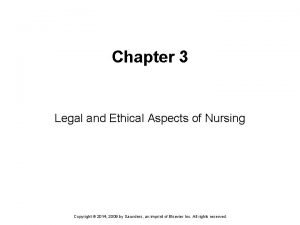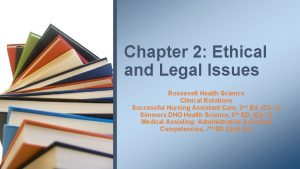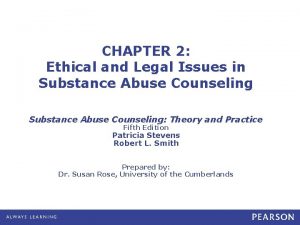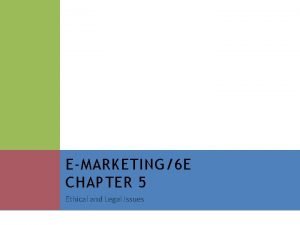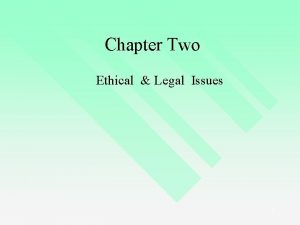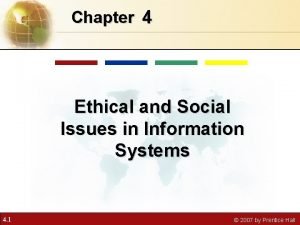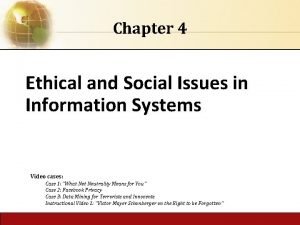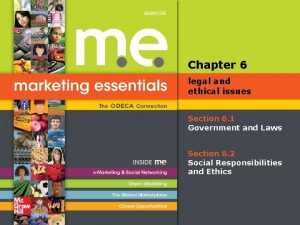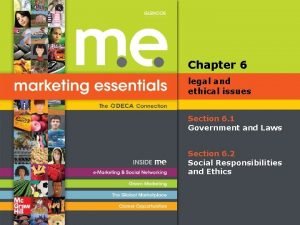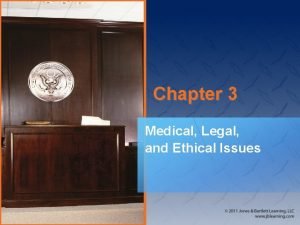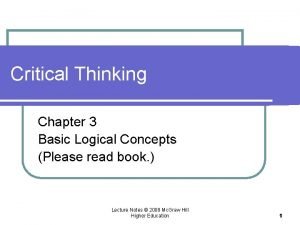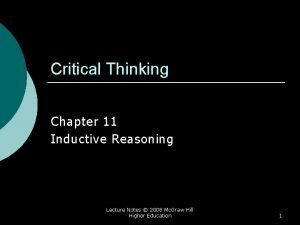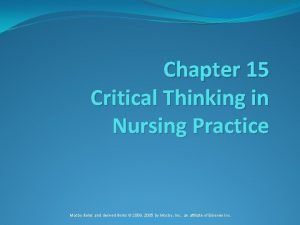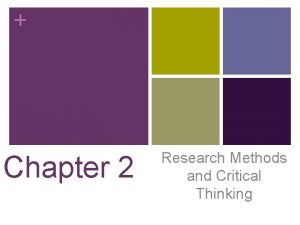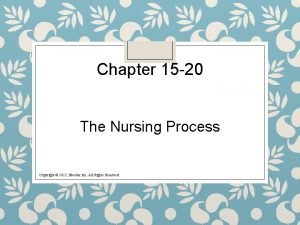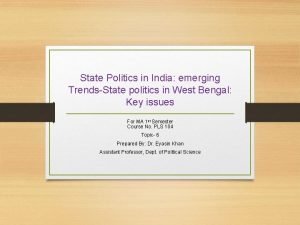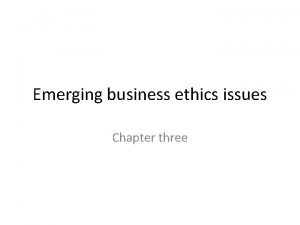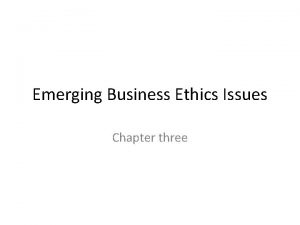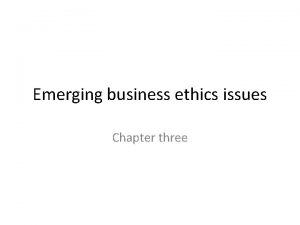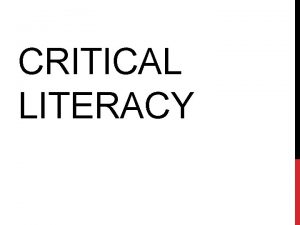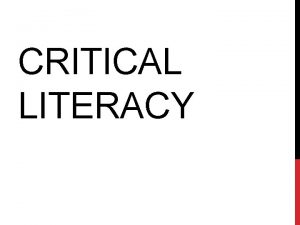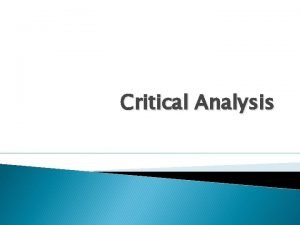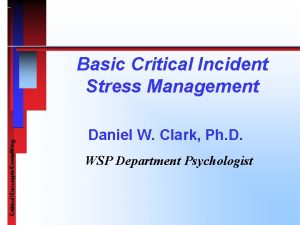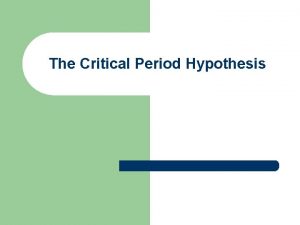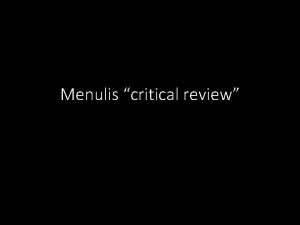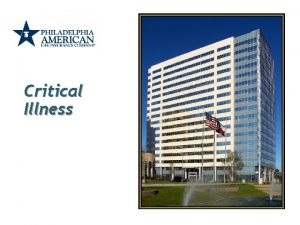Chapter 13 Critical Emerging School Finance Issues Emerging























































































- Slides: 87

Chapter 13 Critical & Emerging School Finance Issues

Emerging Issues in School Finance Include: Investing resources to build or renovate schools Financing school capital outlay Providing appropriate compensation for quality teachers Charter schools, vouchers, privatization Court rulings, and federal, state, and local support for public education

School Facilities In times of tight budgets, cutting books and building repairs never results in public outcries If athletic programs, drivers’ education, or band uniforms are cut, the public becomes agitated & vocal Deferred maintenance of school facilities has grown to widespread proportions

1995 GAO Report: GAO (General Accounting Office) in 1995 provided Congress with information about the condition of America’s public school facilities The report indicated it would take $112 billion to repair or upgrade America’s public schools to “good overall condition”

1999 Center for Educational Statistics Report: Half of American schools have at least one building feature in “less than adequate” condition About 40% of American schools have at least one unsatisfactory environmental condition Most oldest buildings in greatest need of repair, have no plan for improvement. About 10% of American school buildings have enrollments that are greater than 25% more than the designed capacity

Congressional Budget Denies Funds Congress failed to pass capital-outlay legislation that would have started to address these needs In 1995, budget requests for $5 billion and in 1999 a scaled down request of just under $1 billion were denied

2000 NEA Study Found that it would take $322 billion to repair and to modernize America’s schools and provide schools with the necessary technology

Selected 1995 School Facility Needs America’s schools are in disrepair. The average public school is 42 years old Twenty-eight percent of the public schools in America are over 50 years old America’s schools can’t support today’s technology Forty-six percent of the public schools in America lack the electrical & communication wiring to support today’s computer systems

Unmet State School Facility Needs Alabama $ 2, 310, 853, 117. California $ 32, 901, 183, 414. Florida $ 5, 487, 697, 936. Kansas $ 2, 296, 811, 280. New York $ 50, 675, 796, 800. Ohio $ 24, 977, 840, 000. Texas $ 13, 654, 055, 206. Total for 50 states $322, 955, 416, 998.

School Construction, 1993 -2002 – in $ Billions 1993 $ 10, 778. 1995 $ 10, 417. 1998 $ 17, 095. 2000 $ 21, 567 2002 $ 24, 343.

Estimated Public School Construction Costs, 2003 -05 New School Construction Additions $51, 162, 337, 000. Modernizations $27, 208, 060, 000. Total $15, 352, 273, 000. $93, 722, 670, 000.

Approximate Cost of Construction Principal & Interest Construction Interest Rate Cost Interest Total Building Cost $1, 000 3% $517, 774 $1, 000, 000 4% $718, 694 $1, 000, 000 5% $932, 559 $1, 000, 000 6% $1, 158, 383 $2, 158, 383

Interest Raises School Construction Expenses Borrowing money for school construction is an additional expense If a locality or state can borrow funds at 5% for thirty years, every $1 million borrowed will cost an additional $932, 000 – virtually doubling the cost Borrowing the same amount at 3% for the same time costs about 50% of the loan amount

Approximate Cost of Principal & Interest Construction Cost Interest Rate Interest $1, 000 3% $517, 774 Total Building Cost $1, 517, 774 $1, 000 5% $932, 559 $1, 000, 000 6% $1, 158, 383 $2, 158, 383

Arbitrage & Financing School Construction Webster defines “arbitrage” as purchasing in one market for immediate sale in another at a higher rate Arbitrage is one way of helping to reduce interest costs in financing school facilities

Arbitrage & Financing School Construction, cont. Schools are municipal entities. As such, financing them is a safe investment with certain tax advantages to those willing to finance their construction Safer investments with tax advantages usually bear a lower interest rate than riskier investments As such, bonds or certificates can be issued by the school system or by the governing authority for up to $25 million per year

Arbitrage & Financing School Construction, cont. Let’s say that the Alpha School District needed $25 million for a new school. Bonds or Certificates of Participation (COPS) for the municipal project would be drawn up for sale at a rate of 2% state, free of state taxes, for 30 years School District A can then invest those proceeds at a higher rate of interest for a period of 18 months and keep the interest difference, or spread

Health Issues & School Facilities Radon gas Lead paint & solder Indoor air quality Mold

Health Issues & School Facilities: Radon Gas Radon gas: a naturally-occurring gas formed from decomposing uranium found in most soils 2 nd leading cause of lung cancer in the U. S. responsible for between 15, 000 and 22, 000 deaths each year Detection and treatment are important in schools as younger lungs are thought to be more susceptible to damage

Health Issues & School Facilities: Lead paint & lead solder in older plumbing joints cause health risks to young children Almost 1 million children ages 1 -5 have elevated lead levels Lead combines with blood’s hemoglobin, depriving the brain of oxygen & replacing it with lead This leads to neurological impairments and learning problems

Health Issues & School Facilities: Indoor Air Recently constructed “energy efficient” school buildings were designed to avoid letting air conditioning & heat out of the building When a building is too energy efficient and does not let fresh air into the system, problems occur Today 6. 3 million school-aged children suffer asthma & miss more than 14 million school days a year

Health Issues & School Facilities: Molds exist where water and oxygen allow spores to grow Many molds can trigger allergens causing asthma and other allergic reactions Some molds produce toxins that can be lethal Children are most susceptible to the effects of mold

Human Resources & School Finance Employee compensation consumes somewhere between 70 -80% of school budgets. Attracting & retaining quality staff involves policy decisions about human resources and how educators are paid through Basic salary schedules Fringe benefits Professional development Licensure/certification requirements

1963 - The Equal Pay Act was designed to “eliminate pay or wage discrimination based on sex where equal work, equal skills, and equal effort are performed under the same working conditions” Became part of Title VII of the Civil Rights Act of 1964 and outlawed discrimination based on sex, and race, color, religion, and national origin Radically changed teacher pay

A Structured Salary Scale for Teachers In the teaching profession’s early days, men’s and women’s pay scales varied Married heads of households were paid more than single men Elementary teachers were paid less than high school teachers Frequently, teaching or administrative jobs were favors given for political affiliation and loyalty

A Structured Salary Scale for Teachers, cont. A typical salary scale today is based on years of experience and degrees Many scales provide for a step increase each year for 30 years Stipends are provided for graduate degrees

Structured Salary Scales for Teachers Vary Greatly In City A, it takes 28 years to reach the salary scale’s top In City B, it takes only 23 years to reach the maximum teacher salary City A has a fixed annual supplement for advanced degrees City B has a separate pay scale for each additional sets of credits & degrees Which teacher earns more over a career?

Structured Salary Scales for Teachers Vary Greatly Some school districts give raises in fixed dollar amounts Other districts give raises in constant percentage increases Which teacher earns more over a career?

Hypothetical Salary Scale Step 3% Step $1500 Step Difference 1 $40, 000 0 5 $45. 020 $46, 000 ($980) 10 $52, 190 $53, 500 ($1310) 15 $60, 503 $61, 000 ($497) 20 $70, 140 $68, 500 $1, 640 Sum Increase $1, 074, 806 $1, 085, 000 ($10, 194)

Teacher Salary Scales In a business where salaries are 7080% of expenditures, it is vital to know how to spend the funds to best effect. v Does the salary structure attract and retain the highest quality educators? v What is being rewarded by the salary schedule? v Who should be rewarded by the salary schedule?

Teacher Salary Trends Are Important Salary trends are important in attracting and retaining quality teachers. States that do not keep their salaries competitive will have difficulty employing quality teachers – and increasing student achievement.

Which Starting Salary Attracts Quality Teachers? $34, 258 – 44 th highest $42, 212 – 18 th highest $36, 479 – 36 th highest $30, 265 – 51 st highest

Which Starting Salary Attracts Quality Teachers? $53, 507 1 st highest $33, 249 – 47 th highest $37, 109 – 33 rd highest $50, 515 – 5 th highest

Salary schedules show what is valued and rewarded in the school district culture. A salary structure may have the best goals & foster the best policy to attract and retain quality people, but it will not be successful without involvement of those impacted by the schedule & their understanding & agreement, which is a political process.

Teacher Licensure & Certification Licensure and certification are a state’s method for approving teachers for professional practice Certification serves as a professional benchmark for teacher quality All fifty states have some form of certification process

Teacher Quality & NCLB Current No Child Left Behind standards for “highly qualified teachers” include that teachers must: Have a Bachelor’s degree Full state certification or licensure Prove they know the subjects they teach

Teacher Licensure & Certification During teacher shortages, some states have decided that instead of raising teacher salaries to attract more high quality candidates into the profession, it would be less expensive to change the certification requirements This alternative certification route usually shortens the traditional pathway into the profession in terms of coursework and internship hours

National Board Teacher Certification This rigorous certification process is recognized in all 50 states with many providing additional monetary incentives to those holding NBPTS certification Three recent studies find that NBCTS’ students outperform peers in grades 3 -6 on standardized achievement tests Policy questions involve whether to pay more for NBPTS teachers, & how to fairly involve more of them in low-achieving schools

National Board Teacher Certification, cont. How much should states invest in NBCT? North Carolina has supported NBPTS efforts by reimbursing teachers for application fees upon successful certification and provided a 12% salary increase As a result, North Carolina has the highest concentration of NBPTS certified teachers in the nation at an annual cost of $25 million How big a stipend should NBCTs receive & what students populations should they teach?

Benefits – Non-Wage Compensations 5 categories: Paid leave - sick leave, vacations, & holidays Supplementary pay - overtime pay Retirement - defined benefit & defined contribution plans Insurance - life, health, & disability Legally required of the employer – Social Security, Workers’ Compensation, Federal & State Unemployment Taxes

Benefits rank second only to salary and good working conditions in motivating employees to work to high levels Benefits are important to employees. They are not taxed and provide services they would not or could not provide for themselves without the employer’s assistance The benefits provided educators vary widely across the United States

Teachers’ Benefits, 2004 Hourly salary for public school teachers was $33. 47 Fringe benefits totaled $11. 61 per hour Benefits are not included in paychecks If Hourly & Fringe Benefits were combined, the average annual teacher salary would be $53, 552

Teachers’ Benefits, 2004 Fringe benefits total almost 35% of total wages and salaries Retirement costs account for employers’ largest benefit cost with health insurance as the second largest cost

Legally Required Benefits Social Security benefits, also known as FICA, have a cost to both employee and employer The employee and employer each contribute 7. 65% of salary up to $90, 000 for a total of 15. 3% Workers’ Compensation insures risk from employmentrelated injuries & has varied costs, depending upon an incidence rate over time Unemployment insurance is paid by employers

Legally Required Benefits Most never consider the costs of these legally-required benefits Employers’ personnel costs pay for much more than salary

Retirement Benefits Vary Widely North Carolina provides fully paid heath insurance benefits for retired teachers after only 5 years of service Some districts allow retired employees to purchase rate plan insurance Others do not provide this service after the defined COBRA period of severance to keep insurance costs low

School Finance & Health Care Costs Providing health care benefits is emerging as a critical and contentious factor in school finance In 2004, for example, workers’ health care premiums in 35 states rose at least three times faster than their earnings, despite reductions in coverage

School Finance & Health Care Costs, cont. Workers’ costs for employer-sponsored health insurance have risen by 36 % since 2000; earnings increased only 12. 4 % Employee contributions have increased 57% since 2001 for individual coverage, 49% for family Employer-sponsored insurance premiums have jumped 11. 2 % in 2004 In addition, employers estimate that health care costs will rise almost 13 % on average each year if they make no changes in their health plans

School Finance & Health Care Costs, cont. As a result, workers’ average monthly contribution to premiums for family coverage has more than quadrupled, rising from $52 in 1988 to $222 in 2004 The 2004 health insurance cost for a typical family of four past $10, 000, five times the rate of inflation, & three times faster than average earnings in the past four years Today’s family insurance premium represents 21% of the national median household income

School Finance & Health Care Costs, cont. The U. S. health care industry has placed substantial economic pressures on all employers As a result, educators’ insurance programs increasingly want to reduce benefits, increase copayments, and limit the number of “family” members eligible to receive these expensive compensations Unless school divisions place limits on benefits, the financial burden threatens to overwhelm available resources

Employers Reduce Their Health Care Costs From 2001 to 2004, the proportion of workers and dependents receiving employer-sponsored health coverage fell from 65 percent to 61 percent – 5 million fewer jobs provide health benefits Other employers are sharing more of the costs through larger employee payroll contributions or higher out-of-pocket expenses 200 major employers surveyed said they 80% planned to increase co-payments or cost share compared with 65% in 2001

Factors Increasing Health Care Costs Patients’ overuse of medical resources because they do not pay the full costs Administrative & paperwork costs Fear of malpractice suits lead to administering medically unnecessary tests & procedures The medical needs & demands of 77 million baby boomers Escalating prescription drugs’ prices Consumer expectations for easier & broader access to care

Factors Increasing Health Care Costs In addition, Wall Street pressures on for-profit health plans to raise premiums in order to increase profits also plays an important role The U. S. ’s HMO’s showed combined net profits of $10. 2 billion in 2003, up 87% from $5. 5 billion in 2002 and 345% from $2. 3 billion in 2000 Blue Cross and Blue Shield plans alone saw their total profits reach $5. 4 billion in 2003, up 63% from 2002 and 164% from 2000

No Easy Solutions to Rising Health Care Costs Policy makers disagree Patients, policy analysts say, need to again become the central actor in the medical marketplace and be given the same motivation to economize on medical care that they have to economize in other markets Consumers cannot buy a Cadillac health care program on a Chevrolet willingness to pay, & increasingly low medical co-payments lull medical consumers into a false – and wasteful – sense of economy

School Districts Respond to Health Care Costs Significantly reduce benefits Significantly increase patient costs (premiums, deductibles, co-payments, and changing out-ofpocket limits) Slow salary growth Limit hiring, increase outsourcing, or Dropping insurance coverage, altogether Levy surcharges in 2005 on employees who sign up for family benefits when their spouse was eligible for health coverage through a separate job

School Districts Respond to Health Care Costs, cont. Cost shifting to employees is inevitable as employers redesign their benefits packages to protect their “financial exposure”

Same-Sex Domestic Partner Benefits Controversy Involves significant economic aspects Because health care benefits – including medical, dental, and vision coverage – are an increasingly important part of the compensation that employees earn & because such benefits are usually available to spouses and family members, homosexual employees believe that they are under-compensated unless they receive similar benefits for a designated “domestic partner”

Same-Sex Domestic Partner Benefits Controversy A small number of states, cities, and major companies provide domestic partner benefits to their employees. California is leading the U. S. in instituting protections for gay and lesbian couples without a court mandate. In Hawaii and Vermont, state courts compelled their legislatures to extend equal benefits to same-sex couples.

Same-Sex Domestic Partner Benefits Controversy, cont. Religious groups and conservative who believe that this policy constitutes a social endorsement of homosexuality as an acceptable alternative lifestyle had contentiously opposed this trend Nevertheless, public opinion has shifted to the extent that most Americans support many domestic partner benefits

Same-Sex Domestic Partner Benefits Most public school districts do not now offer benefits to samesex couples Public universities appear more accepting of providing health benefits to same-sex partners

Same-Sex Domestic Partner Benefits, cont. When the courts can carefully separate religion and government practices, the ban on same-sex insurance benefits may be clearly seen as a religious rather than a civic objection & school human resources practices will adjust

Emerging Issue: Vouchers – using state funds to pay for other public or private education NCLB legislation allows parents of the lowestscoring students attending schools that have not made Adequate Yearly Progress for several years to request vouchers to attend other schools, either private, parochial, or public

No Child Left Behind Act, 2001 NCLB’s requirements include: States develop approved student achievement testing programs Schools make Adequate Yearly Progress (AYP) towards 100% of its students passing those tests by School Year 2013 -14 Highly qualified teachers be placed in every classroom by 2005 -06 Compliance failure involves sanctions for schools and transfer opportunities for students

No Child Left Behind Act, 2001, cont. The cost for states & localities to implement NCLB has not been fully researched In Ohio alone, the cost is estimated to be as high as $1. 447 billion in addition to already existing programs for its 1. 8 million students. . . an additional $800 per student per year Policy Issues: Should failing schools be reconstituted, closed, or punished financially? Should they be provided additional resources and support?

Another Perspective: School Efficiency Examining standards/ student achievement and consequences from a financial efficiency point of view instead of sanctions Examining efficiency with student performance data is the key to resource distribution for troubled schools

School Efficiency is defined as using the resources in a manner that maximizes the outputs Using production function studies, a dual metric system allows delineation of 4 types of schools

School Efficiency, cont. High-performing, efficient schools would be left alone to serve as models High-performing, inefficient schools would be required to increase achievement or give up some of the financial or support services Low-performing, efficient schools would be given additional resources Low-performing, inefficient schools would be reconstituted

School Efficiency, cont. If schools were distributed evenly across these four quadrants, the cost of implementing NCLB from an efficiency metric would reduce the overall implementation costs Such an approach might save even more in terms of human resources cost and public relations capital

NCLB & School Efficiency If the $800 additional cost per pupil for NCLB in Ohio is repeated nationally, the cost would be staggering 53. 8 million students enrolled in school for the 2004 -05 school year An additional $800 per pupil the additional cost to education would be $43, 040, 000 each year

Vouchers: A Political Issue As NCLB legislation stands in 2004, parents of the lowest-scoring students attending schools that have not made Adequate Yearly Progress over time may request vouchers to attend other schools – private, parochial, or public

Vouchers: A Political Issue, cont. Vouchers have been a political battle cry for opposing sides of the issue since Milton Friedman first proposed them Using vouchers was addressed by the United States Supreme Court in June, 2002 when it ruled 5 -4 in favor of Cleveland’s voucher program with the Zelman case

Vouchers: Zelman Case, 2002 The U. S. Supreme Court considered whether the voucher program established to help parents with children in failing Cleveland schools, violated the First Amendment’s Establishment Clause The program offered limited income parents of lowest scoring students the choice of attending private schools and receiving tutoring In August, 1999, a federal district court rejected the program as favoring religion, therefore, violating the constitution

Vouchers: Zelman Case, 2002, cont. On June 27, 2002, the majority ruled that the program was … “is a program of true private choice … neutral in all aspects to religion” In this decision, the Court leaned towards approval of privatization in education without violating the First Amendment Since the Court sees “privatization” as a continuum, the essential element of separation of church and state, however, will prevail

Vouchers: Florida, 2004 A Florida Appeals Court ruled on August 16, 2004 that the State’s first voucher law was unconstitutional because it violated State Constitution provisions of providing funds to private, sectarian schools It was sent to the Florida Supreme Court for review in August, 2004 If the Florida voucher laws are to pass, voters will have to amend the State Constitution

Vouchers: A U. S. National Survey The 2004 PDK/Gallup Poll shows the public opposes vouchers by 54% to 42% (with 4% who “do not know”) With that level of public sentiment opposing vouchers, it is unlikely that legislation will pass to foster such court rulings

Federal Support for Education Without a major political shift, no big changes in federal education funding appear imminent Federal politicians seem content to let the states bear the major burden of funding schools Longstanding programs may be subject to recissions Funds will likely be shifted or eliminated from other programs and placed in ESEA funding

State Support for Education The primary responsibility for the funding of education lies with the state As such, the states have to pay for larger and larger percentages of education budgets with NCLB’s accountability – especially if federal revenue remains flat or declines slightly

State Support for Education, cont. No NEW Lobbying for increased state funding may cause political TAXES!! infighting within state legislatures as state politicians increasingly eye U. S. NO TAXES! Congressional seats Running for office with a Cut history and platform of tax TAXES!! cuts has proven an effective ticket to Washington politics

State Support for Education, cont. As of 2004, 20 states have legal contests at the state supreme court level regarding their funding formulae This legislative tactic to increase state funding on adequacy issues in the courts appears to be a back door approach to finding increased state revenue These partisan state politics may well increase as federal dollars remain flat and accountability levels increase

State Support for Education, cont. Education associations (at the local, state, and national levels), educators, administrators, and higher education personnel will need to work for a unified method to increase funding for the good of all students Public education supporters, teachers, and association representatives must avoid divide and conquer strategies to fragment the support base for increased education funding

Local Support for Education Local support for education is likely to increase in high capacity, high effort areas There is also a growing resentment from these areas with state equalization efforts. More frequently, equalization is referred to as “Robin Hood” laws The clear meaning is that states are engaged in stealing funds from the rich localities to give to the poor localities

Local Support for Education, cont. • Low capacity localities will experience increased stress to meet NCLB requirements for AYP (adequate yearly progress) • These “high needs” areas are suffering from higher teacher turnover and teacher shortages from retiring baby boomers • Localities need state policy assistance to help in recruiting highly qualified teachers

Connecticut’s Strategy The state's 1986 Educational Enhancement Act that spent over $300 million to boost minimum beginning teacher salaries made it possible for lowwealth districts to compete in the job market for highly qualified teachers

Connecticut’s Strategy, cont. Raised teacher licensing standards by requiring a major in the discipline to be taught Required extensive knowledge of teaching and learning as part of preparation Instituted performancebased examinations to test subject matter & teaching knowledge as basis for receiving a license Created a state-funded mentoring program for first -year teachers Created an elaborate assessment program

Connecticut’s Strategy, cont. Analysis of the strategy’s outcomes found that it eliminated teacher shortages and emergency hiring in the high poverty cities and created surpluses of teachers within three years of its passage

If states do not provide increased equalization programs for attracting high quality teacher applicants to low capacity localities, the achievement gap will increase, resulting in even greater economic disparity between high and low capacity localities

Conclusion Schools face varied and competing demands for limited fiscal resources Devastating student health and achievement issues lie at the heart of school finance, & local school districts face wrenching decisions about how to best spend their inadequate education dollars for the maximum return
 Critical semi critical and non critical instruments
Critical semi critical and non critical instruments Semi critical instruments in dentistry
Semi critical instruments in dentistry Emerging role of financial manager in india
Emerging role of financial manager in india Trends in community development
Trends in community development Introduction to industrial relations
Introduction to industrial relations Emerging issues in taxation
Emerging issues in taxation Ethical issues in accounting and finance
Ethical issues in accounting and finance Finance and accounting issues in strategy implementation
Finance and accounting issues in strategy implementation Karan srivastava md
Karan srivastava md Critical issues in student affairs
Critical issues in student affairs Slidetodoc.com
Slidetodoc.com Contcloud
Contcloud Emerging technology chapter 5
Emerging technology chapter 5 Emerging technology chapter 5
Emerging technology chapter 5 Emerging technology chapter 2
Emerging technology chapter 2 Emerging technology chapter 4
Emerging technology chapter 4 Chapter 22 life in the emerging urban society
Chapter 22 life in the emerging urban society Emerging technology chapter 5
Emerging technology chapter 5 The byzantine empire and emerging europe
The byzantine empire and emerging europe Us army finance school
Us army finance school Texas recapture districts
Texas recapture districts Texas public school finance overview
Texas public school finance overview Texas school finance 101
Texas school finance 101 School finance systems
School finance systems Deped financial management operations manual ppt
Deped financial management operations manual ppt Csfp colorado
Csfp colorado Critical encounters in high school english
Critical encounters in high school english Chapter 2 personal finance
Chapter 2 personal finance Fundamentals of corporate finance chapter 6 solutions
Fundamentals of corporate finance chapter 6 solutions Chapter 1 introduction to corporate finance
Chapter 1 introduction to corporate finance Personal finance 6th edition
Personal finance 6th edition Fundamentals of corporate finance chapter 1
Fundamentals of corporate finance chapter 1 Principles of corporate finance chapter 3 solutions
Principles of corporate finance chapter 3 solutions Examples of agency problems
Examples of agency problems Chapter 1 review personal finance
Chapter 1 review personal finance Chapter 8 personal finance
Chapter 8 personal finance Chapter 4 post test personal finance
Chapter 4 post test personal finance Chapter 1 post test personal finance
Chapter 1 post test personal finance Overview of personal finance chapter 1
Overview of personal finance chapter 1 Chapter 1 introduction to corporate finance
Chapter 1 introduction to corporate finance Chapter 1 introduction to corporate finance
Chapter 1 introduction to corporate finance Chapter 1 introduction to corporate finance
Chapter 1 introduction to corporate finance The basic tools of finance chapter 27
The basic tools of finance chapter 27 Fundamentals of corporate finance, chapter 1
Fundamentals of corporate finance, chapter 1 The basic tools of finance chapter 27
The basic tools of finance chapter 27 Chapter 20 today's issues in africa
Chapter 20 today's issues in africa Ethical and legal issues chapter 2
Ethical and legal issues chapter 2 Chapter 3 medical legal and ethical issues
Chapter 3 medical legal and ethical issues Chapter 3 legal and ethical issues
Chapter 3 legal and ethical issues Chapter 20 today's issues in africa
Chapter 20 today's issues in africa Legal and ethical issues chapter 5
Legal and ethical issues chapter 5 Medical legal and ethical issues chapter 3
Medical legal and ethical issues chapter 3 Chapter 11 today's issues in latin america
Chapter 11 today's issues in latin america Chapter 9 inventories additional valuation issues
Chapter 9 inventories additional valuation issues Chapter 6 legal and ethical issues
Chapter 6 legal and ethical issues Legal and ethical issues chapter 5
Legal and ethical issues chapter 5 Chapter 4 ethical and social issues in information systems
Chapter 4 ethical and social issues in information systems Ethical issues in qualitative research chapter 4
Ethical issues in qualitative research chapter 4 Chapter 3 legal and ethical issues
Chapter 3 legal and ethical issues Chapter 2 ethical and legal issues
Chapter 2 ethical and legal issues Ethical and legal issues chapter 2
Ethical and legal issues chapter 2 Chapter 5 legal and ethical responsibilities
Chapter 5 legal and ethical responsibilities Legal and ethical issues chapter 5
Legal and ethical issues chapter 5 Chapter 2 ethical and legal issues
Chapter 2 ethical and legal issues Chapter 4 ethical issues
Chapter 4 ethical issues Chapter 4 ethical issues
Chapter 4 ethical issues Lower of cost or market
Lower of cost or market Chapter 4 ethical and social issues in information systems
Chapter 4 ethical and social issues in information systems Chapter 6 legal and ethical issues
Chapter 6 legal and ethical issues Chapter 6 legal and ethical issues
Chapter 6 legal and ethical issues Chapter 3 legal and ethical issues
Chapter 3 legal and ethical issues Chapter 23 today's issues southwest asia
Chapter 23 today's issues southwest asia Critical thinking chapter 3
Critical thinking chapter 3 Chapter 11 critical thinking
Chapter 11 critical thinking Chapter 9 critical thinking answers
Chapter 9 critical thinking answers Literature map example
Literature map example Critical thinking chapter 2
Critical thinking chapter 2 Chapter 41 telephone techniques critical thinking
Chapter 41 telephone techniques critical thinking Kataoka-yahiro and saylor's model
Kataoka-yahiro and saylor's model Chapter 1 critical thinking
Chapter 1 critical thinking Psychology research methods worksheet answers
Psychology research methods worksheet answers Fundamentals of nursing chapter 15 critical thinking
Fundamentals of nursing chapter 15 critical thinking Chapter 1 problem solving and critical thinking
Chapter 1 problem solving and critical thinking Clarivate analytics emerging sources citation index
Clarivate analytics emerging sources citation index Emerging technology synthesis
Emerging technology synthesis Explain emerging patterns of state politics in india
Explain emerging patterns of state politics in india Psychosocial development in young adulthood
Psychosocial development in young adulthood Emerging proficient extending
Emerging proficient extending





